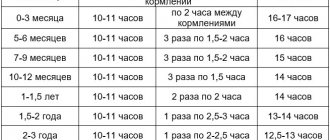Home › Baby up to one year › Feeding
Author of the article
Lyudmila Sergeevna Sokolova Pediatrician of the highest category
Reading time: 5 minutes
AA
Article last updated: 04/29/2019
Every young mother dreams of feeding her newborn baby on her own. This is not only beneficial for the health of mother and baby, but allows you to establish close psychological contact. But sometimes situations arise when breastfeeding is impossible, and the child must be switched to artificial nutrition. Artificial feeding involves a balanced approach to choosing a formula and introducing a certain diet. Before introducing PI into your child’s diet, you should consult with your pediatrician.
Is it possible to use free feeding during artificial feeding?
A free diet in the full sense of the word (feeding according to the baby’s wishes and requirements) is possible only with breastfeeding, and partly with mixed feeding.
Why? Because human milk, unlike artificial formula, “knows how to adapt” to changing circumstances: the baby drank less mother’s milk at the previous feeding (and this is “not visible”), which means that in subsequent feedings it will make up for it - either in quantity (volume) , or quality (calorie content). Everything happens naturally, requiring no regulation. With artificial feeding, such calculations are impossible. Therefore, for children in the first months of life, it is recommended to feed 6-7 times a day - every 3 or 3.5 hours with a 6-hour (or 6.5-hour) break at night, respectively. It is recommended that babies 4-5 months old after the introduction of the first complementary foods be fed 5 times a day.
Artificial formula cannot be given in large quantities at once; the transition to completely artificial feeding should be “displacement” - within 5-7 days. On the first day, formula milk can be given in a small volume, no more than half of one feeding. Gradually increase your portions over the course of a week. But if you have breast milk, even in minimal quantities, I repeat: be sure to breastfeed your baby first!
The doctor’s recommendations, taking into account the individual characteristics of the child, will even help you adjust artificial feeding: if the baby does not eat the proposed volume of formula during one feeding, it means that he needs more frequent feedings, but in smaller portions. In this sense (maximum consideration of the child’s individual characteristics and needs, determined with the help of a specialist), we can talk about partial “free feeding”.
The main reasons why it is necessary to introduce formula into your baby’s diet
Even the highest quality milk formula cannot replenish all the micro- and macroelements that babies receive from their mother’s breast milk. The introduction or replacement of individual entrepreneurs should always be considered and have a certain justification. Pediatric doctors identify several situations in which it is necessary to introduce artificial formulas:
- Recovery of a woman in labor after a particularly difficult birth;
- Prescribing vital medications to the mother in labor;
- Infection with infectious diseases;
- Insufficient or absent breast milk. Nutritional sufficiency is determined by weighing the baby immediately after feeding;
- Inability to breastfeed due to prolonged absence of the mother.
Breastfeeding is worth fighting for until the end. Even a small amount of breast milk brings invaluable benefits to the baby.
Initially, you should try to establish lactation with the help of special medications. If the expected result was not obtained, then the IP is introduced.
How often can artificial formulas be changed?
Unfortunately, there is still an opinion that it is necessary to change formulas until the most suitable one for the child is found. This is not true: a child’s body is not capable of so quickly and, worse, constantly rebuilding itself. Even adults can’t handle such a load - try radically changing your diet every day...
Carefully monitor how the child assimilates new food: is there any constant regurgitation, rashes, problems with stool, etc. But take your time: maybe in a day or two the red spots on the cheeks will go away, the stool will improve, the tummy will hurt less - that means , the gastrointestinal tract has adapted to a new type of nutrition.
If in doubt, consult your doctor. But you can’t change mixtures arbitrarily and often! Having chosen the most adequate mixture, leave it as the main diet throughout the first year of life.
Transition diagram
Changing the baby's diet should be carried out according to a well-developed scheme. If you replace the formula correctly, this event will pass without unpleasant consequences or harm to the child. The baby will experience minimal stress and discomfort.
Today, there are various schemes on how to switch to a new diet. They involve the slow introduction of another mixture into the infant's diet. At the same time, the mother should monitor the baby’s body’s reaction to the new product, since formulas may not be suitable for some newborns. The fact is that such a transition takes a fairly long period of time - up to three weeks. If the child is allergic to the new formula and has stool disorders, an accelerated transition is required.
Rapid power replacement plans suggest making the transition in six days. However, they do not exclude the possibility of side effects in the baby. Therefore, the selection of a suitable scheme should be made according to the specific situation.
An express method for introducing a new mixture with five and seven meals a day is shown in the following table:
| Reception day | Quantity per dose (in grams) | Total quantity per day (in grams) |
| 1 | 10 | 10 |
| 2 | 10 | 30 |
| 3 | 20 | 60 |
| 4 | 50 | 250 |
| 5 | 100 | 400 |
| 6 | 150 | more than 600 |
How to calculate the amount of formula for feeding?
When artificial feeding, it is important to correctly determine the required amount of nutrition for the child. Use the so-called "volumetric method". In the first two months of life, the amount of basic food received per day should be 1/5 of the child’s body weight. At the age of 2 to 4 months - 1/6 of body weight, at 4-6 months - 1/7 of body weight, after 6 months - 1/8-1/9 of body weight. If a baby weighs 5 kg 700 grams at 3.5 months (that is, 5700 grams), then per day he should eat 950 ml of an adapted mixture: 5700: 6 = 950. Of course, the approximate amount of nutrition should be clarified for each child depending on the state of his health, physical development, appetite, etc. All issues related to artificial feeding must be resolved “not by eye,” but in consultation with a pediatrician.
To find out how much food is needed in one feeding, divide the daily volume of food by the number of feedings: 950:6 = 158, approximately 160 g. Juices, water, fruit and vegetable decoctions are not included in calculating the volume of artificial formula. But when the baby begins to receive vegetable puree, yolk and cottage cheese - complementary foods, take this into account when determining the required volume of the mixture.
Introduction of special medicinal mixtures
If the baby reacts poorly to standard adapted artificial nutrition, then the pediatrician in such cases may prescribe medication. Only a doctor can determine the need for such a transition and the timing of taking special food. One month is enough for one child in a gentle regime, while another has to be administered a medicinal mixture for a longer period. There must be strict indications for the introduction of such mixtures.
- A deficiency of the enzyme that helps digest lactose requires a lactose-free diet.
- Intolerance to animal milk proteins requires the introduction of low-lactose or soy milk.
- Severe allergic reactions and significant disturbances in nutritional processes contribute to the introduction of a semi-elementary mixture into the diet.
- If the baby often spits up or vomits, then he is prescribed an anti-reflux mixture.
How to properly prepare artificial formula for nutrition?
First, read the method for preparing the mixture indicated on the package. It must be carefully observed, since the wrong dosage will immediately affect the child’s health. If there is too much powder, the mixture is obtained with an increased content of all nutrients, and this can lead to external negative reactions (frequent regurgitation, vomiting, unstable stool, etc.) and, what is much more dangerous, to excessive stress on vital organs and systems of the child - kidneys, liver, pancreas, intestines, etc.
If too little powder is taken, the mixture will turn out to be low-calorie, and this is also bad: the baby, while remaining hungry, will be capricious, sleep worse, and gain less weight.
What water should I use to prepare mixtures?
Even if ordinary tap water has passed through a household filter, it is necessary to boil it! You can also buy special bottled water for preparing baby food. It is now produced by many baby food manufacturers, both foreign and domestic.
On the eve of the summer season, I would like to pay attention to the following:
- If water is taken from a country well or a village spring, this in no way guarantees its quality.
- If you are not sure about the quality of water, use liquid breast milk substitutes rather than dry ones - those provided in dairy kitchens. High industrial sterility and microbiological standards are guaranteed in ready-made liquid mixtures. At the same time, strictly follow the rules for storing and transporting “Agushki” and children’s kefir in packaging!
BabyMother
How to change the formula for a child
Mommies, please reason with me! We've been having problems with our tummy lately, and I'm thinking about switching to a new formula. But more and more often I hear that the mixture cannot be changed suddenly, is this true?
Lately, my character and overall personality have begun to change... Not in a bad way, no.... rather, just becoming more mature... !. He began to defend what was in his hands (earlier he shouted MAMA))))) 2. He began to invent a game and invite me......
Change the mixture again????
Good morning everybody! Girls, please tell me, we have been on IV for a month, now we are 3 months old, we ate Nutrilon premium, my daughter has been refusing food for any reason lately (she will fall asleep, then she will get distracted, then she…
Is it possible to change food suddenly?
My friend’s child (boy) is 1.7 years old. They, like us, are artificial and in the same way eat purees, porridge and puddings from Heinz. Of course, this is not the main food: there are also homemade soups, porridges, stews in...
Should I change the mixture?
Hi all! I’ve been reading posts on this site for almost three months now and have always found answers to questions. But today I registered myself, because I can’t find a similar situation... My boy is three months old. Full GV...
I'm changing!
By the fifth planning cycle, I finally realized that pregnancy should not be an obsession! You can’t live constantly counting the days and looking for symptoms! You can’t make plans for the near future by considering two options: “If I B...
why change anything
I accidentally came across a very interesting and relevant article. I couldn’t help but share))))) “Everything you want is just outside your comfort zone.” Robert Allen. It happens to you like this: you are lying on the sofa, looking, covered with a blanket,...
A sharp jump or 9 months
I think this time my post will help some mothers calm down and allow the child to wait for his finest hour. Not so long ago I wrote a post about how Dee prefers the zucchini rhythm of life, that he doesn’t want...
To change the mixture or not to change?
Good morning! Girls, I’m at a crossroads, I don’t know what to do to make Lala eat better...feeding hasn’t worked out for us since birth ((((the baby refused to latch on to the breast, then we had colic during feeding...
Abrupt transition to another mixture
I’m in a panic; after 6 months of eating Nutrilak, my daughter began to refuse it. At the beginning there was little of it, eating 90 ml maximum... And then for 2 days I DON’T EAT AT ALL! I'm going to change the mixture, but how...
Should I change the mixture?
The problem is that lately the baby’s cheeks have been constantly covered in dust, but just a little, atopicity is present. We eat NAS 1. Naturally, we don’t eat complementary foods yet. Most likely there is a dysbacteriosis, we were tested at 2 months, treated,…
Every young mother dreams of feeding her newborn baby on her own. This is not only beneficial for the health of mother and baby, but allows you to establish close psychological contact. But sometimes situations arise when breastfeeding is impossible, and the child must be switched to artificial nutrition. Artificial feeding involves a balanced approach to choosing a formula and introducing a certain diet. Before introducing PI into your child’s diet, you should consult with your pediatrician.
Even the highest quality milk formula cannot replenish all the micro- and macroelements that babies receive from their mother’s breast milk. The introduction or replacement of individual entrepreneurs should always be considered and have a certain justification. Pediatric doctors identify several situations in which it is necessary to introduce artificial formulas:
- Recovery of a woman in labor after a particularly difficult birth;
- Prescribing vital medications to the mother in labor;
- Infection with infectious diseases;
- Insufficient or absent breast milk. Nutritional sufficiency is determined by weighing the baby immediately after feeding;
- Inability to breastfeed due to prolonged absence of the mother.
Breastfeeding is worth fighting for until the end. Even a small amount of breast milk brings invaluable benefits to the baby.
Initially, you should try to establish lactation with the help of special medications. If the expected result was not obtained, then the IP is introduced.
Before switching to formula, you should weigh all the positive and negative aspects of such feeding.
The main advantages when choosing an individual entrepreneur:
- The child can be fed by other relatives. At this time, mom can go about her business or even work. The child will not suffer from hunger.
- When feeding from a bottle, the mother can always estimate the amount of food eaten and will immediately pay attention to poor health if the baby begins to eat poorly.
- An allergic reaction is usually associated with artificial formula. In this case, you can replace the IP, and there is no need to revise your diet.
- The baby remains full for a longer period because the formula takes longer to digest.
Negative aspects of introducing artificial feeding:
- Children on PI are much more likely to suffer from ARVI and allergies. This is due to the lack of certain substances that strengthen the baby’s immunity. Such substances are found only in breast milk.
- Bottle feeding requires keeping bottles clean and sterile at all times.
- Babies often suffer from colic because using a pacifier allows air to enter the esophagus;
- If you travel, you must take everything with you.
- When selecting a suitable individual entrepreneur, you often have to buy several types of it, which are subsequently not used.
- High-quality food is not cheap, which will require additional financial expenses from parents.
Sometimes situations arise when the IP needs to be replaced. Artificial nutrition must fully meet the current needs of the child. But you need to introduce a new diet of any type (adapted or therapeutic) starting with a very small amount. Then the volume is gradually increased, while reducing the previous mixture.
Another mixture is administered in the following situations:
- Personal food intolerance. Allergic reactions may occur, gastrointestinal disorders will constantly recur, or constipation may occur;
- Age indicators. Each IP has its own subtypes, designed for a specific age. At six months of age there comes a time when it is necessary to move to the next level. If the child absorbed the previous food well, then it is better not to change the manufacturer.
- For medical reasons, it became necessary to introduce a therapeutic IP. They are administered exclusively as prescribed by the pediatrician.
- Returning from medicinal mixtures to regular ones after eliminating health problems.
The transition to another PI for a newborn must be carried out in accordance with certain rules.
Initially, you need to introduce a new mixture by mixing it with your usual diet.
The new artificial mixture is introduced little by little in accordance with the rules.
WE RECOMMEND! A unique author’s methodology “Literogram” for the intellectual and emotional development of children from 4 to 15 years old! The main objective of the program is the progressive development, formation and correction of oral and written speech. Learn more
At the first dose, approximately two-thirds of the old formula and one-third of the new food are given. They are prepared in different bottles. After three to four days the proportion is equalized, and the mixtures are given in equal quantities. In the next two days, the old PC is given one part, and the new one is given three parts. After a week, you can give your baby a full meal of the new formula. Over seven days, the volume of new food increases from 10 ml per day to 600 ml.
Quite often, mothers independently decide to change the formula to another, which, in their opinion, will be better suited. Moreover, they give new food in full at one time. In a couple of days everything can happen again. You will be very lucky if the child does not react in any way to such experiments. But quite often this can cause stomach upset or an allergic reaction. This may be due not only to the fact that the IP was selected incorrectly, but also to a violation of the regime for entering a new one.
The human body adapts to a new diet within a few days. Due to the introduction of a new type of feeding, after a few days a reaction from the gastrointestinal tract may occur (colic, constipation, or vice versa, loose stools). On the fourth or fifth day the situation returns to normal. If problems with the digestive system are accompanied by rashes or peeling of the cheeks, then you should definitely show your child to a pediatrician. Perhaps the new diet is simply not suitable for the baby.
At the age when the transition to a new stage of nutrition occurs, the child already begins to sit, get on all fours, and tries to crawl. By this age, active teething begins. New products are starting to be included in the menu. All this greatly affects both psychological and physiological development.
Everything should take place against the backdrop of pleasant emotions and you should not, for example, aggravate teething with problems with intestinal function in connection with the replacement of IP. In addition, inflammatory processes in the oral cavity can also cause gastrointestinal disorders. And as a result, you can simply draw incorrect conclusions about the causes of health problems. Also, you should not vaccinate or introduce new food into the diet during a change of IP. You can slightly shift the timing of certain events.
If the baby reacts poorly to standard adapted artificial nutrition, then the pediatrician in such cases may prescribe medication. Only a doctor can determine the need for such a transition and the timing of taking special food. One month is enough for one child in a gentle regime, while another has to be administered a medicinal mixture for a longer period. There must be strict indications for the introduction of such mixtures.
- A deficiency of the enzyme that helps digest lactose requires a lactose-free diet.
- Intolerance to animal milk proteins requires the introduction of low-lactose or soy milk.
- Severe allergic reactions and significant disturbances in nutritional processes contribute to the introduction of a semi-elementary mixture into the diet.
- If the baby often spits up or vomits, then he is prescribed an anti-reflux mixture.
Quite often, an allergic reaction to baby food can manifest as disturbances in the gastrointestinal tract. In such cases, it can cause constipation, diarrhea, excessive regurgitation, painful colic or skin rashes. In extreme, particularly severe cases, allergies can cause shortness of breath. In such situations, you must immediately call an ambulance.
It happens that changing the proportions when preparing IP helps eliminate an allergic reaction. To do this, reduce the amount of dry component. Or you need to select a different mixture. To prevent dysbiosis, the pediatrician may prescribe a mixture based on fermented milk products or with probiotics.
If the rash on the child’s body is quite intense, then you can try changing it to food made from goat’s milk. Such milk is in no way inferior to cow's milk in its nutritional characteristics, but causes allergic reactions much less frequently. If these actions do not give positive results, then the only options left are either a soy mixture made from plant proteins, or a hypoallergenic one. The latter is taken only as prescribed by a doctor.
A change of individual entrepreneur should be carried out according to general rules. Adaptation of the body takes place within five to seven days and there is no need to make sudden changes, especially with food allergies.
If nothing helps, and the allergy does not go away, then the baby is transferred to a special mixture that does not contain proteins at all. Instead of proteins, amino acids are included in the composition.
With age, these problems may disappear without a trace. This is due to the formation of the digestive system. The most important thing for parents is to try not to aggravate the problem and not worsen the child’s condition. You should also not solve such problems alone; you should definitely contact your pediatrician.
Often breastfeeding has to be replaced with formula. The need may arise due to loss of milk from the mother, or due to a lack of fat content. If the child was fed one type of formula, and after some time the parents decided to switch to another option, you need to know how to do it correctly.
Instructions
Switch to another type of mixture only in stages. Start with a small amount and gradually work your way up to the desired amount. Simultaneously with the increase
new mixture
, minimize the amount of one that needs to be discarded. Remember that any milk formula is diluted strictly in accordance with the recommendations indicated on the packaging
In the first few days after the transition to
new mixture
At each feeding, try to give no more than 2/3 of the amount of nutrition he needs according to his age. Replace the remaining 1/3 with either water (boiled) or weak tea.
Watch your child carefully. If any rashes, frequent regurgitation, or stomach upset occur, immediately stop feeding this type of formula and contact your pediatrician immediately. At your appointment, be sure to consult about the appropriate mixture, which should be prescribed taking into account the allergic reaction that has occurred.
After the final selection of the mixture, you no longer need to look for options for replacing it. If this milk formula is suitable for the child, then it cannot be better. The main thing is that the baby is healthy and grows normally. It will already be quite difficult for the child’s stomach to adjust to a new diet, which in itself is stressful, so you should not make it worse by frequently changing the diet, but just let the child get used to a good formula.
If the search for a new milk formula began because the child has stopped gaining weight, then there is no need to rush into changing the diet. This phenomenon will relate to natural physiology. Of course, you can try to switch the baby to a formula that contains more nutrients, but you can’t rush - the child is simply growing in leaps and bounds.
It is not worth changing the formula often for another reason - regularly changing the formula will lead to great stress for the body and can not only stop the child’s weight gain, but also lead to weight loss. If weight gain does not occur for more than 2 weeks, contact your pediatrician for recommendations.
Remember that under no circumstances should you change the formula immediately as soon as you notice a change in your baby’s stool. If such a symptom occurs, consult a doctor; you should not make independent decisions if you are not a pediatrician. It is important not to harm the child, but to help. If at the same time the child remains quite active and in a good mood, then most likely everything is in order.
How often can you change formula milk?
Breastfeeding is important for the health and development of children, because along with the product of lactation, maternal antibodies, beneficial bacteria and enzymes that help improve the functioning of the digestive system enter the baby’s body. In addition, by slightly changing her diet, a nursing mother can adjust the functioning of the baby’s intestines - “fix” it or, conversely, “loosen” it.
Artificial babies receiving formula are deprived of all this. If there are persistent problems with the baby’s digestion or health, the pediatrician may recommend changing the product and even recommend a specific manufacturer.
If an artificial baby feels good eating the formula that they started feeding him in the maternity hospital, then there is no need to change it for no reason. The baby’s intestines get used to a specific product, which it has already learned to digest and assimilate, and changing the diet can harm its functionality, which will lead to intestinal disorders.
If you decide to switch to another formula because it is inexpensive compared to what you are giving your newborn now, you should definitely ask your pediatrician for his opinion on this matter. Over many years of working with infants, a pediatric specialist has probably accumulated enough practical knowledge about the reactions of babies to products from different manufacturers. The doctor will help you choose the ideal option that suits your baby’s body and is affordable for you.
Often the pediatrician himself may recommend that you change the mixture to another:
- with prolonged disturbances in the baby's stool;
- with the development of anemia;
- in case of allergic reactions to the product used;
- with excessive regurgitation of the baby;
- with regular bloating.
Manufacturers are ready to meet the needs of every artificial baby. So, if the baby suffers from excessive regurgitation, you can solve this problem by switching him to a special anti-reflux product containing gum, which effectively thickens the contents of the stomach. For children with lactose intolerance, powders have been created without its presence in the composition, and if you are allergic to animal protein, you can purchase food for your child with soy or hydrolyzed protein, which will not cause such a reaction in him.
If anemia is detected in a child, the pediatrician will decide to temporarily switch him to iron-fortified powder. But the most common problem for which doctors recommend changing food products is dysbiosis. Artificial animals have nowhere to get lacto- and bifidobacteria, so they are either additionally given special preparations that populate the microflora, or are switched to a mixture with probiotics.
In any case, you need to change your child’s formula strictly after agreeing on your decision with your pediatrician.
So, if you eat 180 ml. nutrition, the transition to a new product will look like this:
- 1-2 days - 1 spoon of new powder + 5 spoons of the old one;
- Day 3-4 - 2 spoons of new powder + 4 spoons of old;
- 4-6 days - 3 tablespoons of the new powder + 3 tablespoons of the old one;
- 7-8 days - 4 tablespoons of the new powder + 2 tablespoons of the old one;
- Day 9-10 - 5 spoons of new powder + 1 spoon of old;
- Day 11-12 - complete transition to a new mixture.
Changing mixtures of different brands occurs according to the same scheme - every two days you should increase the volume of the new powder in one of the bottles by 30 ml, and in the container with the old one, reduce it accordingly:
- Day 1-2 - 30ml water +1 l. new powder/150 ml. water +5 l. former;
- Day 3-4 - 60ml water +2 l. new powder/120 ml. water +4 l. former;
- Days 4-6 - 90ml water +3 l. new powder/90 ml. water +3 l. former;
- Day 7-8 - 120ml water +4 l. new powder/60 ml. water +2 l. former;
- Day 9-10 – 160ml water +5 l. new powder/30 ml. water +1 l. former;
- Day 11-12 - complete transition to a new mixture.
The child should first be given a bottle with a new formula, and then fed from a container with the same product.
If you see that the child tolerates the food replacement normally, you can speed up the schedule a little by introducing 30 ml into his diet every day. new product, and reducing the same volume of the previous one.
The scheme for introducing a new food is “stretched” over such a long period of time that the baby’s intestines can adapt and begin to digest and assimilate a different product than he is used to. But even with such reasonable caution, the baby’s body will still begin to react negatively. In the first 3-4 days you can notice in your child:
- Constipation.
- Diarrhea.
- Rapid swelling and colic.
- Minor skin rashes.
If after 3-4 days these signs do not go away or intensify, and the baby constantly screams, contact your pediatrician - perhaps the chosen mixture is not suitable for the baby, and you will have to try another one, introducing it into the child’s diet according to the previous scheme.
Back to contents
A free diet in the full sense of the word (feeding according to the baby’s wishes and requirements) is possible only with breastfeeding, and partly with mixed feeding. Why? Because human milk, unlike artificial formula, “knows how to adapt” to changing circumstances: the baby drank less mother’s milk at the previous feeding (and this is “not visible”), which means that in subsequent feedings it will make up for it - either in quantity (volume) , or quality (calorie content). Everything happens naturally, requiring no regulation.
With artificial feeding, such calculations are impossible. Therefore, for children in the first months of life, it is recommended to feed 6-7 times a day - every 3 or 3.5 hours with a 6-hour (or 6.5-hour) break at night, respectively. It is recommended that babies 4-5 months old after the introduction of the first complementary foods be fed 5 times a day.
Artificial formula cannot be given in large quantities at once; the transition to completely artificial feeding should be “displacement” - within 5-7 days. On the first day, formula milk can be given in a small volume, no more than half of one feeding. Gradually increase your portions over the course of a week. But if you have breast milk, even in minimal quantities, I repeat: be sure to breastfeed your baby first!
The doctor’s recommendations, taking into account the individual characteristics of the child, will even help you adjust artificial feeding: if the baby does not eat the proposed volume of formula during one feeding, it means that he needs more frequent feedings, but in smaller portions. In this sense (maximum consideration of the child’s individual characteristics and needs, determined with the help of a specialist), we can talk about partial “free feeding”.
Back to contents
Unfortunately, there is still an opinion that it is necessary to change formulas until the most suitable one for the child is found. This is not true: a child’s body is not capable of so quickly and, worse, constantly rebuilding itself. Even adults can’t handle such a load - try radically changing your diet every day...
Carefully monitor how the child assimilates new food: is there any constant regurgitation, rashes, problems with stool, etc. But take your time: maybe in a day or two the red spots on the cheeks will go away, the stool will improve, the tummy will hurt less - that means , the gastrointestinal tract has adapted to a new type of nutrition.
If in doubt, consult your doctor. But you can’t change mixtures arbitrarily and often! Having chosen the most adequate mixture, leave it as the main diet throughout the first year of life.
Back to contents
When artificial feeding, it is important to correctly determine the required amount of nutrition for the child. Use the so-called "volumetric method". In the first two months of life, the amount of basic food received per day should be 1/5 of the child’s body weight. At the age of 2 to 4 months - 1/6 of body weight, at 4-6 months - 1/7 of body weight, after 6 months - 1/8-1/9 of body weight. If a baby weighs 5 kg 700 grams at 3.5 months (that is, 5700 grams), then per day he should eat 950 ml of an adapted mixture: 5700: 6 = 950. Of course, the approximate amount of nutrition should be clarified for each child depending on the state of his health, physical development, appetite, etc. All issues related to artificial feeding must be resolved “not by eye,” but in consultation with a pediatrician.
To find out how much food is needed in one feeding, divide the daily volume of food by the number of feedings: 950:6 = 158, approximately 160 g. Juices, water, fruit and vegetable decoctions are not included in calculating the volume of artificial formula. But when the baby begins to receive vegetable puree, yolk and cottage cheese - complementary foods, take this into account when determining the required volume of the mixture.
Back to contents
First, read the method for preparing the mixture indicated on the package. It must be carefully observed, since the wrong dosage will immediately affect the child’s health. If there is too much powder, the mixture is obtained with an increased content of all nutrients, and this can lead to external negative reactions (frequent regurgitation, vomiting, unstable stool, etc.) and, what is much more dangerous, to excessive stress on vital organs and systems of the child - kidneys, liver, pancreas, intestines, etc.
If too little powder is taken, the mixture will turn out to be low-calorie, and this is also bad: the baby, while remaining hungry, will be capricious, sleep worse, and gain less weight.
Back to contents
Even if ordinary tap water has passed through a household filter, it is necessary to boil it! You can also buy special bottled water for preparing baby food. It is now produced by many baby food manufacturers, both foreign and domestic.
On the eve of the summer season, I would like to pay attention to the following:
- If water is taken from a country well or a village spring, this in no way guarantees its quality.
- If you are not sure about the quality of water, use liquid breast milk substitutes rather than dry ones - those provided in dairy kitchens. High industrial sterility and microbiological standards are guaranteed in ready-made liquid mixtures. At the same time, strictly follow the rules for storing and transporting “Agushki” and children’s kefir in packaging!
Back to contents
The ideal temperature for artificial milk formula is 36-37°C. To obtain this temperature, you need to pour hot boiled water (50-60°C, rated as “hot” with your lips) into a bottle and measure out the required amount of powder using a measuring spoon from the mixture package. After pouring the powder into the water, quickly stir it until completely dissolved.
Shake the bottle thoroughly and place a few drops of the resulting (reconstituted) mixture on your wrist (or press the bottle to your temple). The contents should be close to body temperature, that is, practically not felt.
Back to contents
If the baby has not drunk the entire prepared portion of the formula, under no circumstances leave the rest until the next feeding! All items and baby utensils necessary for artificial feeding should be washed immediately after feeding, using hot water and baking soda (1 teaspoon per liter of water).
Popova Olga
Did you like the article?
Rate this article
Discussion
please tell us at what age and what can be introduced into a child’s diet. There are too many different opinions.
08/20/2006 17:28:56, Olga
Intelligible and understandable, the word is a good article!
Good article, immediately removes all questions.
.
Hello, we have the following problem: Our girl is 1 month old. From the very beginning, we were breastfed and the “Malyutka” formula, which is what it says on the box, that it is sugar-free, and that it is possible from age 0. Everything was fine, but a “kind” nurse came and said that Malyutka was complete crap and that we needed to buy at least Nutrilon. Due to my work schedule, I didn’t notice how my deeply beloved mother-in-law bought this same Nutrilon, and accordingly they began to feed her (daughter) with it. Then it all started, constipation began. When the kind nurse came again, we asked her if it could be that the Nutrilon she recommended, or rather the switch to it, was to blame for our illness? With the calmness of a dead boa constrictor, she said that yes, of course she could. We sensibly reasoned that since such a bad thing had happened, we would now be on Nutrilon. But the problems don't stop. Doctors say take Bifidum bacteria, today they advised you to eat Nan fermented milk once a day. Here’s a question: can’t we just start eating Little One back? Wouldn't this make it worse, or rather, would it make it better? Thanks in advance.
What should the temperature of the mixture be?
The ideal temperature for artificial milk formula is 36-37°C. To obtain this temperature, you need to pour hot boiled water (50-60°C, rated as “hot” with your lips) into a bottle and measure out the required amount of powder using a measuring spoon from the mixture package. After pouring the powder into the water, quickly stir it until completely dissolved.
Shake the bottle thoroughly and place a few drops of the resulting (reconstituted) mixture on your wrist (or press the bottle to your temple). The contents should be close to body temperature, that is, practically not felt.











